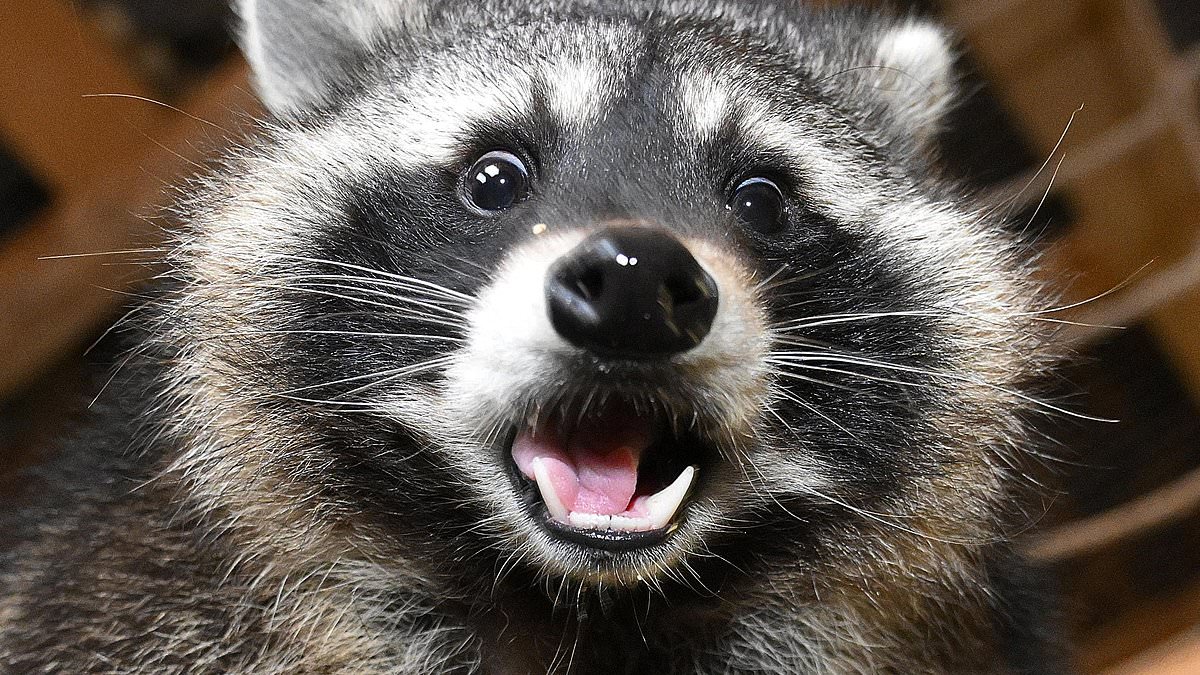With his onyx eyes ringed by black fur, Muffin the raccoon resembled a masked robber and, as I ventured gingerly into his den carrying a bag of banana chips, he looked ready to mug me.
Thankfully, however, his greeting was surprisingly friendly. Plump, round and fluffy, he bounded towards me like a beach ball wrapped in a thick-pile carpet, reared up on his hind legs and took the chips with a humanoid, five-fingered hand.
Watching this fascinating creature nibble his breakfast at a raccoon sanctuary in central Germany, where he has lived since his mother was killed by a car five years ago, I was seized with guilt.
The previous day, you see, I had tucked into sausages, meatballs and burgers made from one of Muffin’s kith and kin. No doubt this will disgust many readers and I, too, baulked at eating one of the bushy-tailed rascals my grandchildren love to see in Disney cartoons and David Attenborough documentaries.
Contradictory as it sounds, however, re-inventing the raccoon as a gourmet delicacy is being suggested as a solution to one of Europe’s strangest and most intractable environmental problems – the great raccoon invasion of Germany.
A century ago there were few if any raccoons living in the wild in the country. But these highly-sexed critters breed rapidly, and after a few were released during the Nazi regime they began to multiply at a dizzying rate.
Astonishingly, experts believe up to two million of the bushy-tailed blighters are now running amok here, decimating wildlife and even attacking people and wrecking homes.
Some argue they should be culled by commercial hunting and sold alongside the bratwurst in supermarkets – so it seemed imperative for me to try their meat.
And, with its soft, chewable texture and gamey flavour – somewhere between venison and pork – I confess to finding it quite delicious.
Judging by the huge success of Michael Reiss, a German hunter pioneering the raccoon meat trade, I’m not alone. Two years ago he began experimenting with recipes, using raccoons he traps in cages. He showcased his dishes at a Berlin food fair, winning plaudits. Since then, word has spread and, despite not advertising, demand is soaring.
Though he still runs his business from his village home in Saxony-Anhalt – skinning his quarry in the backyard and employing a chef to turn raccoons into meatballs, soup, pate, sausages and salami – he now ships his wares across Germany.
Reiss can catch up to ten raccoons a night and, as each one provides at least 2kg of edible meat, retailing at around £75, his annual turnover is already more than £150,000.
Last week alone his sales totalled £5,000, half of which was profit. Reiss also sells raccoon foods from a mobile stand at events and runs a well-stocked shop, all of which invite me to wonder whether I’m meeting the world’s first raccoon tycoon.
The rugged outdoorsman, a 46-year-old father of sons aged 12 and five (the younger of whom likes to help him ‘cut off the raccoons’ feet’, he tells me airily) smiles at the thought.
‘Come back in 2035 and we’ll see. There could be a Porsche outside,’ he says, adding that he wouldn’t enjoy the stress of becoming a big supplier. But he can foresee someone ‘stealing’ his lucrative idea and getting backers, perhaps on Germany’s version of Dragon’s Den.
Should that happen, we might find raccoon salami in Aldi. Or, given its niche appeal, Waitrose. For, according to a new survey of 2,000 Germans, conducted at Berlin University, the majority would readily eat raccoon.
By now, you may be wondering whether I’ve got the wrong country. After all, the raccoons we see in films invariably scamper around North America, their native territory and home to some 10 million of them – half the global population. That they are overrunning Germany may come as a surprise. The origins of this Teutonic raccoon boom are hotly disputed and have become a sensitive political issue.
Some researchers blame Nazi marshal Hermann Goering who, as head of the Third Reich’s forestry department and Hitler’s official hunting master, reputedly ordered two pairs of North American raccoons to be released in a forest near the Edersee Dam, in 1934.
Ironically, the Gestapo founder is said to have freed the voracious predators, believing they would enrich the ecology. This would have been in keeping with Nazi ideology, holding that nature should be manipulated to suit their Darwinian ‘survival of the fittest’ ideals.
Some top Nazis were also keen recreational hunters and apparently eager to target a new game species.
However, the notion that modern Germany is still in the grip of ‘Nazi Raccoons’ has always been uncomfortable, and a few years ago Horst Marohn, a state forestry official in Hessen, claimed to have found archive documents disproving Goering’s personal involvement.
Indeed, according to Marohn, the Third Reich’s leading zoologist had reservations about releasing raccoons, having seen how a pair that escaped from his garden bred quickly, then preyed on his ducks and guinea pigs. Marohn says a local forestry boss had the idea to release them.
Yet another theory holds that by the 1930s they were already living wild in Germany.
Since the late 19th century, raccoons had been farmed for their fur but when the economy crashed in 1929 there was no market for fashion accessories and bankrupt German raccoon farmers opened their cages.
For the next quarter of a century, as the Second World War came and went and the nation was split between the Eastern and Western Blocs, nobody took much notice of the raccoons’ steady rise.
However, as females can produce seven or eight babies, or ‘kits’, in a litter, and raccoons in Germany have few natural enemies – unlike in North America, where they are preyed on by bears, cougars, pumas and eagles – their numbers multiplied.
They also have many predatory attributes – acute night vision, an ability to swim, climb sheer surfaces, run at 15mph, plus innate cunning and an IQ almost equal to that of monkeys. They also have an appetite for most small animals, birds, insects, reptiles and fish (as well as berries and nuts).
By the mid-1950s, some German naturalists feared the interlopers were endangering native species.
The first state to try curbing the population was Hessen, where Goering (or the forestry boss) had released those first breeding pairs. In 1954, officials allowed them to be shot or trapped in baited cages under hunting laws – a move later followed by other regions. But though they are now widely culled – 200,000 last year alone – these doughty creatures, which can grow to the size of a spaniel, are now found everywhere. In some towns you are more likely to see a raccoon than a fox wandering the streets.
The acknowledged ‘raccoon capital of Germany’ is Kassel, which has been colonised by an estimated 30,000 of them – one for every seven residents. This may be because of its closeness to the Edersee Dam and its network of waterways, beside which raccoons like to nest.
Yet urban raccoons don’t just live in the undergrowth; they often break into houses, making dens in lofts and attics. And, compared with raccoons, the destruction caused by rats and mice is trivial.
One man who sees the appalling damage they cause, not only to properties but to the owners, some of whom have been seriously injured by their knife-sharp claws and teeth, is Alexander Knauf, Kassel’s intrepid raccoon rustler. Two years ago, he was working as a surveyor. Hearing the horror stories, however, he began offering his services to householders and businesses desperate to get rid of raccoons, charging about £325 for each one he killed, and now makes a handsome living. Last year he killed about 150 and this year his tally has already passed 200.
As a devout Christian, Knauf, 36, admits his macabre work troubles him. He finds their haunts and leaves coffin-shaped boxes baited with food, which snap shut when they go inside. He then ushers them into a smaller cage, takes them away and shoots them. But sometimes, when they leap at him, he is forced to use his knife.
If all this sounds gruesome, a supposedly compassionate clause in the raccoon hunting regulations can actually make his work crueller. It decrees that nursing mother raccoons can’t be killed because this would leave their offspring to starve. Like other hunters, however, Knauf has found a loophole.
Since there is nothing to prevent baby raccoons being hunted, he will catch and kill them first.
Then, as the mother no longer has any dependents, he is allowed to finish her, too. ‘I try to do it quickly and efficiently, but it is not a nice job,’ he says euphemistically. ‘Sometimes the babies are just a few days old and unable to crawl, so I can reach into the nest and grab them.
‘As I’m taking them, tears will often run down my face. But I justify what I do morally and ethically because I see the terrible suffering these animals cause to the householders.’ Knauff shows me videos of some of the homes he has cleared, and the images are indeed shocking. After the raccoons break in, usually by dislodging roof slates, their ammonia-enriched urine soaks into the ceiling, which eventually crumbles. Their pee is so corrosive it can even eat through concrete. Families in Kassel have had to demolish and rebuild their entire houses.
Then there are the physical injuries. When one farmer tried to clear a raccoon away from his chicken coop, stabbing it with a pitchfork, he was so deeply clawed that he lost the use of a hand.
One woman found one nesting in her laundry and tried to wrap it in a towel to take it to a rescue centre. She was attacked so badly that she contracted sepsis.
The European Union is so concerned by the raccoons’ destruction of native animals that in 2016 it was included on a list of 1,800 ‘invasive species’. It became illegal to keep, sell or import raccoons, and member states were obliged to introduce measures to control them. Since then, more licensed hunters have set the raccoons in their sights and, though the animal rights lobby protests, many consider culling a necessary evil.
It would be more effective and humane, the anti-culling lobby insists, to adopt other control measures, such as a mass sterilisation programme.
Having listened to the desperate last scratches of a raccoon caught in a trap this week, and met the endearing Muffin, I tend to agree. By the same token, it is clearly time for radical action.
While hardline raccoon defenders deny they pose an environmental threat, doom-mongers fear Germany faces a new ‘Silent Spring’.
Rapacious raccoons could leave the countryside devoid of birdsong, buzzing insects, croaking frogs and scurrying animals, they warn.
And the North Sea may not be wide enough to stop Britain becoming their next destination. It would take only a couple of fertile stowaways to slip aboard a freighter.
We all adore those rascally Disney raccoons, of course, and nobody wishes to see them suffer.
Yet, given the misery they can cause and the world food shortage – not to mention their undeniable succulence – isn’t it time for the Germans to leave sentiment aside, round them up on an industrial scale and put them on our supermarket shelves?




